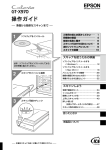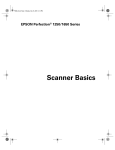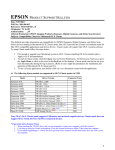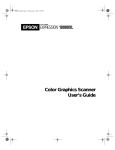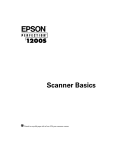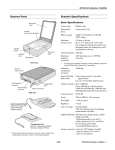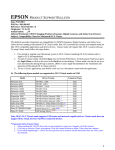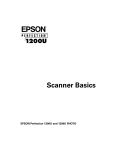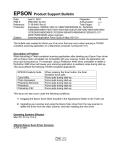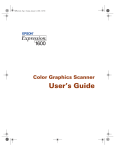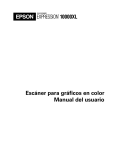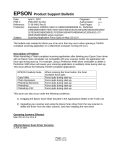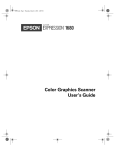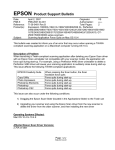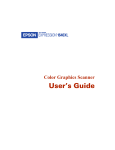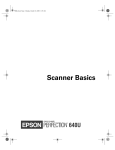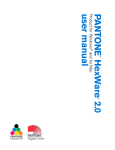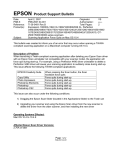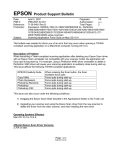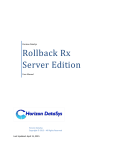Download EPSON Perfection 1640SU Scanner Basics
Transcript
basics.book Page i Thursday, August 31, 2000 10:08 AM EPSON Perfection 1640SU EPSON Perfection 1640SU PHOTO EPSON Perfection 1640SU OFFICE Scanner Basics Printed on recycled paper basics.book Page ii Thursday, August 31, 2000 10:08 AM Copyright Notice All rights reserved. No part of this publication may be reproduced, stored in a retrieval system, or transmitted in any form or by any means, electronic, mechanical, photocopying, recording, or otherwise, without the prior written permission of SEIKO EPSON CORPORATION. The information contained herein is designed only for use with this EPSON scanner. EPSON is not responsible for any use of this information as applied to other scanners. Neither SEIKO EPSON CORPORATION nor its affiliates shall be liable to the purchaser of this product or third parties for damages, losses, costs, or expenses incurred by purchaser or third parties as a result of: accident, misuse, or abuse of this product or unauthorized modifications, repairs, or alterations to this product, or (excluding the U.S.) failure to strictly comply with SEIKO EPSON CORPORATION’s operating and maintenance instructions. SEIKO EPSON CORPORATION shall not be liable for any damages or problems arising from the use of any options or any consumable products other than those designated as Original EPSON Products or EPSON Approved Products by SEIKO EPSON CORPORATION. A Note Concerning Responsible Use of Copyrighted Materials Digital cameras and scanners, like photocopiers and conventional scanners, can be misused by improper copying of copyrighted material. While some countries’ laws permit limited copying of copyrighted material in certain circumstances, those circumstances may not be as broad as some people assume. EPSON encourages each user to be responsible and respectful of the copyright laws when using digital cameras and scanners. Trademarks EPSON and EPSON Stylus are registered trademarks and EPSON Smart Panel is a trademark of SEIKO EPSON CORPORATION. EPSON Perfection and ColorTrue are registered trademarks, and Micro Step Drive, EPSON Software, and EPSON Store are trademarks of Epson America, Inc. General Notice: Other product names used herein are for identification purposes only and may be trademarks of their respective owners. EPSON disclaims any and all rights in those marks. Copyright © 2000 by Epson America, Inc. CPD-10858 8/00 basics.book Page i Thursday, August 31, 2000 10:08 AM Contents A COMPLETE SCANNING SOLUTION 1 About Your Scanner About Your Documentation Cautions, Notes, and Tips 1 2 2 SETTING UP YOUR SCANNER 3 Unpack Your Scanner Choose a Good Place for Your Scanner Unlock the Scanner Connect the Scanner to Your Computer USB SCSI Install the EPSON TWAIN Driver If You’re Running Windows 98 or Windows 2000 . . . If You’re Running Windows 95 . . . If You’re Running Windows NT 4.0 . . . If You’re Using a Macintosh . . . Install the Scanner and Bonus Software Viewing Your Electronic Manuals Viewing Your HTML Reference Guide Viewing Your EPSON Smart Panel PDF Manual 3 4 5 6 6 7 8 8 12 15 17 19 22 22 25 BASIC SCANNING 27 Placing Your Original Document Using EPSON Smart Panel Setting Up the Start Button in EPSON Smart Panel 27 28 29 Contents i basics.book Page ii Thursday, August 31, 2000 10:08 AM ii Scanning Projects Scanning to E-mail Scanning to OCR Scanning and Printing Photos Scanning Something That Doesn’t Fit Under the Document Cover 31 31 32 34 36 ADVANCED SCANNING WITH EPSON TWAIN 37 Scanning with EPSON TWAIN Selecting TWAIN from Your Application Using EPSON TWAIN Selecting TWAIN Settings Tips for Getting the Best Scan Recommended Settings Selecting Resolution Scaling (Resizing) Images 37 38 39 42 43 43 44 44 TRANSPARENCY UNIT 45 Unpacking the Transparency Unit Installing the Transparency Unit Loading Transparencies Using Film Holders Placing the Film Loading 35 mm Negative or Positive Film Loading Brownie Size Film Loading 4 x 5 inch Film Loading Slides and Film Directly on the Document Table Selecting Settings Scanning Reflective (Non-Transparent) Documents or Photographs Removing the Transparency Unit 45 46 47 47 47 48 48 49 50 51 52 52 Contents basics.book Page iii Thursday, August 31, 2000 10:08 AM AUTO DOCUMENT FEEDER 53 Unpacking the Auto Document Feeder Installing the Auto Document Feeder Using the Auto Document Feeder Loading Paper into the Auto Document Feeder Selecting Settings Loading Documents Manually 53 54 55 55 56 57 SCANNER MAINTENANCE 59 Transporting the Scanner Cleaning the Scanner 59 60 PROBLEM SOLVING 61 Scanner Light and Buttons Problems and Solutions Setup Problems Scanner Problems Software Problems Scanning Problems Where To Get Help EPSON Technical Support Bonus Software Technical Support 61 62 62 63 64 67 73 73 74 REQUIREMENTS AND NOTICES 75 System Requirements Windows 75 75 Macintosh Important Safety Instructions FCC Compliance Statement DECLARATION of CONFORMITY 76 77 78 79 Contents iii basics.book Page iv Thursday, August 31, 2000 10:08 AM iv ENERGY STAR Compliance Warranty 79 80 INDEX 83 Contents basics.book Page 1 Thursday, August 31, 2000 10:08 AM A Complete Scanning Solution Your EPSON Perfection® 1640SU scanner is a high-quality scanner for business, home, or school. Using the EPSON® ColorTrue® Imaging System, the scanner captures your images with amazing detail and accurate colors. About Your Scanner Your EPSON Perfection 1640SU scanner includes the following features: ■ Superior image quality: ■ True optical resolution of 1600 dots per inch (dpi) ■ Hardware resolution of 1600 × 3200 dpi with Micro Step Drive™ technology ■ Maximum resolution of 12,800 × 12,800 dpi with interpolation ■ Start button for easy, one-touch scanning ■ 42-bit color and 14-bit grayscale image capture The EPSON Perfection 1640SU PHOTO includes a transparency unit for scanning negatives, slides, and positive film. The EPSON Perfection 1640SU OFFICE includes an auto document feeder to quickly scan multi-page documents. For a list of software included with your scanner, see the inside front cover. A Complete Scanning Solution 1 basics.book Page 2 Thursday, August 31, 2000 10:08 AM About Your Documentation This guide includes instructions for setting up your scanner, scanning tips, and troubleshooting advice. It also includes instructions for viewing your electronic manual. For details on using the scanner software, see your electronic Reference Guide. Cautions, Notes, and Tips Please follow these guidelines as you read your documentation: Cautions must be observed to avoid damage to your equipment. Notes contain important information about your scanner. Tips contain hints for great scanning. 2 A Complete Scanning Solution basics.book Page 3 Thursday, August 31, 2000 10:08 AM Setting Up Your Scanner Setting up your scanner is easy—just follow the simple steps in this chapter in the order listed below. 1. Unpack and choose a place for your scanner. 2. Unlock the scanner. 3. Connect the scanner to your computer. 4. Install the EPSON TWAIN driver. 5. Install the software and view your electronic manuals. Unpack Your Scanner Remove the scanner from the box, then remove the packing material from your scanner. Save the packaging in case you need it later. Your EPSON Perfection 1640SU comes with this Scanner Basics book and the items shown below. scanner USB interface cable 2 or 3 CD-ROMs with driver, electronic manuals, scanner software, and bonus software The EPSON Perfection 1640SU and EPSON Perfection 1640SU PHOTO scanners include three CD-ROMs. The EPSON Perfection 1640SU OFFICE scanner includes two CD-ROMs. Setting Up Your Scanner 3 basics.book Page 4 Thursday, August 31, 2000 10:08 AM The EPSON Perfection 1640SU PHOTO also includes the transparency unit and several film holders. See page 46 for installation instructions. film holders transparency unit The EPSON Perfection 1640SU OFFICE includes an auto document feeder, which comes with the scanner instead of the document cover. See page 53 for instructions on unpacking and installing your auto document feeder. auto document feeder paper support spare paper path guide document mat Choose a Good Place for Your Scanner Here are some points to consider: 4 ■ Place the scanner on a flat, stable surface. If the scanner is tilted, it can’t operate properly. ■ Make sure to place the scanner where you can easily unplug the power cord, and where the USB or SCSI cable can reach your computer. ■ Keep the scanner away from direct sunlight and strong light sources. ■ Avoid places subject to shocks and vibrations, or high or rapidly changing temperatures and humidity. Setting Up Your Scanner basics.book Page 5 Thursday, August 31, 2000 10:08 AM ■ Be sure there’s enough room behind the scanner for the cables, and above the scanner so you can fully raise the document cover. If you’re using the auto document feeder, make sure there’s enough room in front of the scanner to pull out the lower paper support. 18.5 inches (47 cm) when document cover is open 3.8 inches (9.6 cm) when document cover is closed 11.4 inches (28.9 cm) at least 3.9 inches (10 cm) 17.4 inches (44.2 cm) If you attach the transparency unit or auto document feeder to your scanner, the dimensions will differ from the ones listed above. Unlock the Scanner Before connecting the scanner to a power source, you must release the transportation lock, located on the side of the scanner. Turn the transportation lock down to the unlocked position using a coin or similar object, as shown. Setting Up Your Scanner 5 basics.book Page 6 Thursday, August 31, 2000 10:08 AM If you can’t turn the transportation lock easily, plug the scanner in; then, after a minute, unplug the scanner and try again. Always lock the scanner carriage before transporting it; otherwise, the scanner may be damaged. Be sure the scanner lamp is in the home position (toward the back of the scanner). To ensure this, always turn on, then turn off the scanner using the P Operate button before locking the carriage. home position Connect the Scanner to Your Computer You can connect your scanner with SCSI or USB. See the sections below. USB If you are connecting to a PC, Microsoft® Windows® 98 or Windows 2000 must be preinstalled on your system. 1. Make sure the scanner is unplugged, and the computer and any USB devices connected to your computer are turned off. 2. Locate the USB cable that came with your scanner. 6 Setting Up Your Scanner basics.book Page 7 Thursday, August 31, 2000 10:08 AM 3. Plug the square connector on the USB cable into the USB connector on the back of the scanner. Then plug the flat connector into the USB port on your computer or self-powered USB hub. Your system may not work correctly if you use a USB cable other than the one supplied by EPSON or if you connect your scanner through more than one hub. SCSI If your computer does not have a SCSI port, you need to add a SCSI adapter board to your computer. You also need a SCSI cable. See pages 75 and 76 for adapter and cable specifications. Set the SCSI ID Number The scanner is preset at the factory to SCSI ID 2. If you need to change this number, turn the scanner off. Then use the tip of a small flathead screwdriver to turn the rotary switch on the back panel. Be sure to choose a unique number that doesn’t conflict with the ID number of other SCSI devices (including the SCSI interface board itself, which is usually ID 7). Don’t use SCSI ID 8 or 9 for your scanner; these are for factory use only. Don’t use SCSI ID 0 or 1; these are reserved for storage devices. For more information on setting your SCSI ID number, see your electronic Reference Guide, as described on page 22. Setting Up Your Scanner 7 basics.book Page 8 Thursday, August 31, 2000 10:08 AM Connect the Scanner to Your Computer Make sure the scanner, computer, and any SCSI devices connected to your computer are turned off. The scanner is off when the P Operate button is out (not pushed down below the surface of the panel). Attach your SCSI cable to the scanner. The scanner is self-terminated and must be the last device in the chain. Your scanner does not include a SCSI cable. The length of the SCSI cable must not exceed 9.8 feet (3 meters). If you are connecting multiple SCSI devices, the total length of the SCSI bus (cables) must not exceed 19.7 feet (6 meters); otherwise the system may not work properly. Install the EPSON TWAIN Driver The scanner comes with two CD-ROMs: one for Adobe® PhotoDeluxe® and the other for your EPSON TWAIN driver, scanner software, bonus software, and electronic documentation. If you have the EPSON Perfection 1640SU or the EPSON Perfection 1640SU PHOTO, your scanner also includes a third CD-ROM with Adobe Photoshop® 5.0 LE. If You’re Running Windows 98 or Windows 2000 . . . You may be asked to insert your Windows operating system CD-ROM during the scanner installation. Have your Windows CD-ROM handy, in case you need it. The illustrations in this section show Windows 98 screens. The screens in Windows 2000 look different, but the steps are almost identical; any differences are noted in the instructions below. 8 Setting Up Your Scanner basics.book Page 9 Thursday, August 31, 2000 10:08 AM 1. Make sure your scanner is turned on and connected to the computer; then turn on your computer. A screen appears saying that your system has detected new hardware. Then the New Hardware Wizard screen appears. 2. Insert the scanner software CD-ROM in the CD-ROM or DVD drive, then click Next. 3. Select the Search for the best driver for your device option (or Search for a suitable driver for your device in Windows 2000), then click Next. Setting Up Your Scanner 9 basics.book Page 10 Thursday, August 31, 2000 10:08 AM 4. Check Specify a location, click Browse, select the TWAIN 5\WIN98 or TWAIN 5\WIN2000 folder, then click OK. 5. When you return to the New Hardware Wizard, click Next. Windows finds the driver for your scanner and you see the following screen: 6. Click Next to install your TWAIN driver. If your system stops installation and requests files from your Windows operating system CD-ROM, replace your scanner software CD-ROM with your Windows disk and click OK to continue. You may be prompted to re-insert the EPSON disk. 10 Setting Up Your Scanner basics.book Page 11 Thursday, August 31, 2000 10:08 AM 7. In Windows 2000, you see the following screen: Click Yes to finish installing your TWAIN driver. 8. After the scanner software installation is complete, the Screen Calibration utility automatically starts. You must calibrate your screen and scanner to reproduce images closely matching the originals. In the following window, move the slider to the right or left until the shades of the horizontal gray stripes appear similar. View the screen from a short distance. The gray stripes will not perfectly blend together; however, try to make the two tones match as closely as possible. For best print results from an EPSON ink jet printer, select a setting of 1.8. 9. Click OK to register the calibration setting. You don’t need to change the screen calibration again so long as you continue to use the same monitor. If you need to recalibrate your screen at a later time, see your electronic Reference Guide for instructions. Setting Up Your Scanner 11 basics.book Page 12 Thursday, August 31, 2000 10:08 AM 10. Click Finish to exit the New Hardware Wizard. 11. Now you can install your scanner software and bonus software as described on page 19. If You’re Running Windows 95 . . . You may be asked to insert your Windows operating system CD-ROM during the scanner installation. Have your Windows CD-ROM handy, in case you need it. 1. Make sure your SCSI board and SCSI driver are installed and the scanner is connected to your computer. 2. Turn on your scanner first, then turn on your computer. When you see the screen below, click Next. 12 Setting Up Your Scanner basics.book Page 13 Thursday, August 31, 2000 10:08 AM 3. When you see the next screen, click Other Locations. 4. Make sure your scanner software CD-ROM is in the drive. Browse to the following location on your CD-ROM drive: TWAIN 5\WIN95. Then click OK. (The example shows F as the CD-ROM drive. Your CD-ROM drive letter may be different.) 5. When you see the window below, click Finish. Then restart your computer. Setting Up Your Scanner 13 basics.book Page 14 Thursday, August 31, 2000 10:08 AM 6. Once your computer restarts, double-click My Computer, then double-click the Epson CD-ROM icon. The CD-ROM window opens. 7. Double-click EPSON.exe. 8. The software License Agreement appears. After reading the license agreement, click Agree to continue with the installation. 9. You see the Install TWAIN Driver screen. Click Install. Follow the instructions on the screen to install your TWAIN driver. 10. When installation is complete, you see the window on the right. Make sure Perfection1640 appears in the Scanner Selection list. 11. Click Test to check the connection. If the scanner software is installed correctly, you see Status: Device Ready under Scanner Information. Click OK to close the window. 14 Setting Up Your Scanner basics.book Page 15 Thursday, August 31, 2000 10:08 AM 12. After the scanner software installation is complete, the Screen Calibration utility automatically starts. You must calibrate your screen and scanner to reproduce images closely matching the originals. In the following window, move the slider to the right or left until the shades of the horizontal gray stripes appear similar. View the screen from a short distance. The gray stripes will not perfectly blend together; however, try to make the two tones match as closely as possible. For best print results from an EPSON ink jet printer, select a setting of 1.8. 13. Click OK to register the calibration setting. You don’t need to change the screen calibration again so long as you continue to use the same monitor. If you need to recalibrate your screen at a later time, see your electronic Reference Guide for instructions. 14. The Setup completion dialog box appears. Click OK. Now you can install your scanner software and bonus software as described on page 19. If You’re Running Windows NT 4.0 . . . You may be asked to insert your Windows operating system CD-ROM during the scanner installation. Have your Windows CD-ROM handy, in case you need it. 1. Make sure your SCSI board and SCSI driver are installed and the scanner is connected to your computer. 2. Turn on your scanner first, then turn on your computer. 3. Log onto Windows NT® and insert your scanner software CD-ROM in your drive. My Computer, then double-click the 4. Double-click icon. The CD-ROM window opens. 5. Double-click Epson CD-ROM EPSON.exe. 6. The software License Agreement appears. After reading the license agreement, click Agree to continue with the installation. Setting Up Your Scanner 15 basics.book Page 16 Thursday, August 31, 2000 10:08 AM 7. You see the Install TWAIN Driver screen. Click Install. Follow the instructions on the screen to install your TWAIN driver. 8. When installation is complete, you see the window on the right. Make sure Perfection1640 appears in the Scanner Selection list. 9. Click Test to check the connection. If the scanner software is installed correctly, you see Status: Device Ready under Scanner Information. Click OK to close the window. 16 Setting Up Your Scanner basics.book Page 17 Thursday, August 31, 2000 10:08 AM 10. After the scanner software installation is complete, the Screen Calibration utility automatically starts. You must calibrate your screen and scanner to reproduce images closely matching the originals. In the following window, move the slider to the right or left until the shades of the horizontal gray stripes appear similar. View the screen from a short distance. The gray stripes will not perfectly blend together; however, try to make the two tones match as closely as possible. For best print results from an EPSON ink jet printer, select a setting of 1.8. 11. Click OK to register the calibration setting. You don’t need to change the screen calibration again so long as you continue to use the same monitor. If you need to recalibrate your screen at a later time, see your electronic Reference Guide for instructions. 12. The Setup completion dialog box appears. Click OK. Now you can install your scanner software and bonus software as described on page 19. If You’re Using a Macintosh . . . If your iMac™ is running OS 8.1, you’ll need to upgrade your operating system to OS 8.5.1, or later, before installing your scanner software. To find out which operating system your iMac is running, select About This Computer in the Apple menu. 1. Make sure your scanner is plugged in to a power source and connected to the computer. Then turn on your Macintosh® and turn off any virus protection programs. If you see a message stating that you need to install the software for your scanner, click Cancel and continue with step 2 (if you are using OS 8.6, or earlier, click OK). 2. Insert the scanner software CD-ROM in the CD-ROM or DVD drive. 3. Double-click the EPSON CD-ROM icon to open it, if necessary, then EPSON icon. double-click the Setting Up Your Scanner 17 basics.book Page 18 Thursday, August 31, 2000 10:08 AM 4. The software License Agreement screen appears. After reading the license agreement, click Agree to continue with the installation. 5. You see the Install TWAIN Driver screen. Click Install. 6. You see the EPSON TWAIN Driver Installer screen. Click Install to install your TWAIN driver. 7. When the scanner software installation is complete, you see this screen: Click Quit. You see the Screen Calibration window. You must calibrate your screen and scanner to reproduce images closely matching the originals. 8. In the following window, move the slider to the right or left until the shades of the horizontal gray stripes appear similar. View the screen from a short distance. The gray stripes will not perfectly blend together; however, try to make the two tones match as closely as possible. For best print results from an EPSON ink jet printer, select a setting of 1.8. 9. Click OK to register the calibration setting. 18 Setting Up Your Scanner basics.book Page 19 Thursday, August 31, 2000 10:08 AM You will not need to change the screen calibration again as long as you continue to use the same monitor. If you need to recalibrate your screen at a later time, select Screen Calibration in the EPSON Scanner folder. 10. Restart your Macintosh. 11. After your computer restarts, install your scanner software and bonus software as described below. Install the Scanner and Bonus Software Before you begin, be sure any virus protection programs are turned off. Be sure to install EPSON Smart Panel,™ ScanSoft™ TextBridge® Pro, and Adobe PhotoDeluxe to take advantage of your scanner’s ] Start button. Adobe PhotoDeluxe is included on a separate CD-ROM. Follow these steps to install PhotoDeluxe: In Windows, insert the PhotoDeluxe CD-ROM in your drive, double-click My Computer, then double-click the CD-ROM icon. Open the English\Install folder and double-click Setup.exe. Follow the instructions on the screen and then restart your computer. On a Macintosh, insert the CD-ROM in your drive and double-click the CD-ROM icon, if necessary. Double-click the English icon, then double-click the Adobe PhotoDeluxe Installer icon. Follow the steps on the screen and then restart your computer. Follow these steps: 1. Insert the scanner software CD-ROM in your CD-ROM or DVD drive. My Computer, then double-click the 2. Windows: Double-click CD-ROM EPSON.exe. icon. The CD-ROM window opens. Double-click Macintosh: Double-click the EPSON CD-ROM icon to open it, if necessary, EPSON icon. then double-click the 3. The EPSON screen appears. If the software License Agreement screen appears, read the license agreement and click Agree to continue with the installation. Setting Up Your Scanner 19 basics.book Page 20 Thursday, August 31, 2000 10:08 AM The Main Menu appears on your screen. 4. Click Scanner Software. The Scanner Software screen appears. 5. Click EPSON Smart Panel. 6. Click the Install button and follow the instructions on the screen to install EPSON Smart Panel. 20 Setting Up Your Scanner basics.book Page 21 Thursday, August 31, 2000 10:08 AM 7. When the installation is complete, you return to the EPSON Smart Panel install screen. Click Back. 8. From the Scanner Software screen, click ScanSoft TextBridge Pro. 9. Click the Install button and follow the instructions on the screen to install TextBridge Pro. 10. In Windows, when the installation is complete, you return to the TextBridge Pro install screen. Click Back. Click Back again to return to the Main Menu. For Macintosh, click Restart to restart your computer. When your computer restarts, double-click the EPSON CD-ROM icon to open it, if necessary, then double-click the EPSON icon. 11. Click Bonus Software. 12. Click the application name or button for the program you want to install. Setting Up Your Scanner 21 basics.book Page 22 Thursday, August 31, 2000 10:08 AM 13. The install screen appears for the application you selected (the example shown is for ArcSoft™ PhotoMontage™). Click the Install button to install the selected software. (You can skip the installation by clicking the Back button at the bottom of the window.) 14. If the application requires a restart, go back to step 11 after restarting to install another application. If the application does not require a restart, you return to the application’s install screen. Select another application to install or click Back to return to the Main Menu. If any of the software you installed requires a restart and you did not restart when you installed the software, you should restart your computer now. Viewing Your Electronic Manuals You always have easy access to your electronic manuals—just go to the Main Menu screen on your scanner software CD-ROM and click Electronic Documentation. Viewing Your HTML Reference Guide Your scanner software CD-ROM includes an electronic Reference Guide for your scanner. The manual is in HTML format, so you need a browser—such as Microsoft® Internet Explorer 3.0 or later or Netscape Navigator® 3.0 or later—to view it. If you are using a different browser, the pages may not display correctly. 22 Setting Up Your Scanner basics.book Page 23 Thursday, August 31, 2000 10:08 AM A browser is not included on the scanner software CD-ROM. You can view your electronic Reference Guide from the CD-ROM or copy it to your hard drive and view it from there. Follow these steps: 1. Insert your scanner software CD-ROM. My Computer, double-click your 2. Windows: Double-click EPSON icon. drive icon, then double-click the CD-ROM Macintosh: Double-click the EPSON CD-ROM icon, then double-click the EPSON icon. The Main Menu appears: 3. Click Electronic Documentation. The following screen appears: 4. Click View Reference Guide. Setting Up Your Scanner 23 basics.book Page 24 Thursday, August 31, 2000 10:08 AM 5. You can either view the manual from the CD-ROM (View Reference Guide) or copy the manual to your hard drive (Install Reference Guide) and view it from there. For details on viewing the manual, see section below. If you copied the manual to your hard drive, you can access it at any time, as follows: Windows: Select Start, Programs, EPSON, and click Reference Guide. Macintosh: Open the EPSON PERFECTION 1640SU folder and double-click View Reference Guide. When you first open the Reference Guide, you see this screen: Click here to expand the table of contents Click a topic on the left to expand the table of contents. After expanding the table of contents, you can click on the topic you want to view. Closed lists, click to expand Click to go to topic If you see an icon in place of a graphic when viewing your Reference Guide in Netscape Navigator, click the Reload button to load the graphic. 24 Setting Up Your Scanner basics.book Page 25 Thursday, August 31, 2000 10:08 AM Viewing Your EPSON Smart Panel PDF Manual You always have easy access to your EPSON Smart Panel electronic manual—it is automatically copied to your hard drive when you install the software. In Windows, you can access the manual by clicking Start, Programs, EPSON Smart Panel for Scanner, then EPSON Smart Panel for Scanner User’s Manual. On a Macintosh, open the EPSON Smart Panel for Scanner folder and double-click SMART PANEL for Scanner Manual. If you already have Adobe® Acrobat® Reader (version 3.0 or later) on your system, the manual opens in Acrobat Reader automatically. If you don’t have Acrobat Reader, you can install it from the CD-ROM. For guidelines on viewing your electronic manuals using Acrobat Reader, see “Navigating a Manual” below. Your Bonus software may also include electronic manuals in PDF format. After installing the software, check its program folder to see if an electronic manual is available. Navigating a Manual When you open an electronic manual, you’ll see this toolbar: previous page next page first page last page show bookmarks and page With Acrobat Reader, you have several ways to navigate through text: ■ Click on hot topics, which are usually underlined or displayed in a different color. To find out if a topic is hot, move your cursor over it. If the cursor turns into a pointing hand, the topic is hot—you can jump to it by clicking once. ■ Use the bookmark section on the left side of the screen to move quickly to the topic of your choice. Click the Show Bookmarks icon on the toolbar to see the bookmark section, if the manual has bookmarks. Some manuals only have a table of contents, but you can also use this to navigate the manual if the topics are hot. Setting Up Your Scanner 25 basics.book Page 26 Thursday, August 31, 2000 10:08 AM ■ Use the arrow buttons in the toolbar or the vertical scroll bar on the right side of the document to move through a manual. (The box to the left of the scroll bar displays the current page number.) For more information, see your Acrobat Reader online guide. 26 Setting Up Your Scanner basics.book Page 27 Thursday, August 31, 2000 10:08 AM Basic Scanning You can use the EPSON Smart Panel for all types of scanning with a convenient on-screen control panel. Your EPSON Perfection 1640SU also lets you scan directly to a Smart Panel application simply by pressing the ] Start button. If you’re experienced with scanning, you can use the EPSON TWAIN interface to scan with applications like Adobe PhotoDeluxe or any other TWAIN-compliant program. See “Advanced Scanning with EPSON TWAIN” on page 37 for instructions. Placing Your Original Document 1. Raise the document cover and place your document face down on the document table glass. 2. Position the document so the horizontal and vertical edges are carefully aligned with the guides on the top and right side of the document table. 3. Close the document cover slowly. Be careful not to move the document. unscanned area An area of 0.12 inches (3 mm) in from the horizontal and vertical guides is not scanned. The self-adjusting cover allows you to place thick documents on the document table glass without removing it. For instructions, see page 36. If you are using the auto document feeder, see “Using the Auto Document Feeder” on page 55 to load your document. If you are using the transparency unit, see “Loading Transparencies” on page 47 for instructions on how to load negatives and transparencies. Basic Scanning 27 basics.book Page 28 Thursday, August 31, 2000 10:08 AM Using EPSON Smart Panel Follow these steps to use EPSON Smart Panel to scan your document or photo: For instructions on installing EPSON Smart Panel, see page 19. 1. Place your original document(s) face down on the document table, as described on the previous page. 2. Do one of the following to open the Smart Panel: ■ Press the ] Start button on your scanner. ■ Click the ■ Open the Apple menu and select EPSON SMART PANEL. Smart Panel icon on the Windows taskbar. The Start button is set to open the Smart Panel by default. This setting may be changed, however, and can be configured for one-touch scanning. See the section below for details. If you have a modem and e-mail service, you can use your scanner to send photos or documents. The control panel on your computer screen allows you to make copies of printed pages and photos. Automatically scans your image and then opens it in PhotoDeluxe, which guides you through steps to create a print project—such as a calendar, card, label, or web page. 28 Basic Scanning Optical character recognition (OCR) converts a scanned text image into text that you can edit in a word processing format. Gives you an easy way to reprint your photos in any size you want. Automatically scans your image and then opens it in any supported application program on your computer. basics.book Page 29 Thursday, August 31, 2000 10:08 AM 3. Click the icon for your desired scanning option. The window for that option appears and lets you adjust settings for your scan. Follow the on-screen steps for each option. If you select Copy or Photo Print, make sure your printer is turned on and the correct paper type and size is loaded in your printer. You can use Photo Print only with an EPSON Stylus Color or EPSON Stylus Photo printer. For detailed instructions on using each of the Smart Panel options, read your electronic manual for EPSON Smart Panel, as described on page 22. Setting Up the Start Button in EPSON Smart Panel You can configure your ] Start button to automatically scan to any of the options in the EPSON Smart Panel. You need to do the following to configure and use your Start button: ■ Set up the Start button to launch a Smart Panel option ■ Set up copying, printing, e-mailing, scanning, or OCR ■ Copy, print, e-mail, scan, or use OCR with the Start button Follow these steps: 1. Open EPSON Smart Panel: In Windows, click the Smart Panel icon on the Windows taskbar. On a Macintosh, click the Apple menu icon, then click EPSON SMART PANEL. Basic Scanning 29 basics.book Page 30 Thursday, August 31, 2000 10:08 AM 2. From the ] Start Button menu, select the option you want to scan to using the scanner’s Start button. The Start icon appears over the selected option. Start icon appears over selected option click to choose the scanning option for the Start button 3. Click the icon for the selected option. 4. Follow the on-screen steps, as if you were going to scan, and set up the default settings for your Start button scans. The next time you press the ] Start button, the scanner automatically scans, using the option you selected. See page 31 for a detailed example of scanning to e-mail, page 32 for a detailed example of scanning to OCR, or page 34 for a detailed example of scanning and printing photos. When copying or printing, make sure your printer is turned on and has the correct paper size and type loaded. You can use Photo Print only with an EPSON Stylus Color or EPSON Stylus Photo printer. 30 Basic Scanning basics.book Page 31 Thursday, August 31, 2000 10:08 AM Scanning Projects The following sections include step-by-step scanning projects for three of the Smart Panel scanning options: Scan to E-mail, Scan to OCR, and Photo Print. The steps for the other Smart Panel options are similar. For detailed instructions, see your electronic manual for EPSON Smart Panel. Scanning to E-mail You can scan photos or documents and then attach the resulting files to an e-mail message. Follow these steps to scan to e-mail: 1. Open the EPSON Smart Panel: In Windows, click the Smart Panel icon on the Windows taskbar. On a Macintosh, click the Apple menu icon, then click EPSON SMART PANEL. 2. Click the Scan to E-mail icon. 3. Select the document settings for your scans: ■ Select the document type for your source image. ■ Select a destination setting. ■ Check the Scan Multiple Images or Enable Auto Document Feeder boxes if you will be using either of these options. 4. Click Scan. The scanner scans your image(s). 5. Click Specify Name and Format. You see the following: 6. Choose a format for your file(s). If you save your file in the JPEG format, you can select a compression option from the Options list. If you select RTF, your scan is saved as an image in the RTF file; it is not converted to editable text. 7. Click Apply and then click Finish. A screen appears showing any available e-mail programs on your system. Basic Scanning 31 basics.book Page 32 Thursday, August 31, 2000 10:08 AM Your e-mail program must be MAPI-compliant. See your e-mail documentation for details. AOL® is not a MAPI-compliant e-mail application. 8. Select your e-mail program and click Send E-mail. Enter the e-mail address, type in a message and subject, then send your e-mail. If you’re scanning multiple pages without using the ADF, you’ll see a message after each page has scanned. Replace the document on the table and click Yes to continue scanning. When you’re done scanning pages and see the message again, click No. Scanning to OCR You can use EPSON Smart Panel to scan and create editable text files with an OCR (optical character recognition) engine. If you are using the auto document feeder, you can scan multiple pages and turn them into multiple single-page documents or a single multi-page document. Follow these steps to scan to OCR: 1. Open the EPSON Smart Panel: In Windows, click the Smart Panel icon on the Windows taskbar. On a Macintosh, click the Apple menu icon, then click EPSON SMART PANEL. 2. Click the Scan to OCR icon. 32 Basic Scanning basics.book Page 33 Thursday, August 31, 2000 10:08 AM You see the OCR scan settings screen: select the source paper size select a Scan Mode click to scan pages using the auto document feeder click to scan multiple pages from the document table 3. Select the settings for your scan: ■ Select the paper size for your document: you can choose from Letter or A4. ■ Select a Scan Mode: Color, Grayscale, or Black&White (recommended). ■ Check the Scan Multiple Images or Enable Auto Document Feeder boxes if you will be using either of these options. 4. Click Scan. The scanner scans your document and you see the Recognize screen: ■ Select a language for the documents that you’ll be scanning. ■ Select the OCR engine that you want to use to recognize and convert the text. If you select Presto! OCR, you can click the Options button and set up additional options. TextBridge Pro does not work with EPSON Smart Panel on Macintosh systems. Use TextBridge Pro by itself, or use the Smart Panel with Presto! OCR. 5. Click Recognize. The OCR engine recognizes the text. Then you see a screen that lets you choose how you want to save or open the text. Basic Scanning 33 basics.book Page 34 Thursday, August 31, 2000 10:08 AM 6. To save your documents without opening them, click Save. Enter a name and folder in the File Name and Path box, or leave the default name. For multiple documents, each file is assigned the file name you select with a new number. Select one of the available formats for saving your file: TXT, RTF, HTML, or PDF. To open your files for editing, click Open. Select an application from the list. Click Property to change any settings for the way your documents will open. Click OK when you are done making changes to the Property settings, or click Cancel if you don’t want to save your changes. Click Open. When you scan to OCR using the Start button, the pages are automatically opened as individual files in the last application that was selected in Smart Panel’s OCR option. If you’re scanning multiple pages without using the auto document feeder, you’ll see a message after each page has scanned. Replace the document on the table and click Yes to continue scanning. When you’re done scanning pages and see the message again, click No. Scanning and Printing Photos You can scan photos and then print them on your EPSON Stylus® Color or EPSON Stylus Photo printer. You can even print directly from transparencies or negatives if you are using the transparency unit. You can use Photo Print only with an EPSON Stylus Color or EPSON Stylus Photo printer. Make sure you have paper loaded in your EPSON printer and the printer is turned on, then follow these steps: 1. Open the EPSON Smart Panel: In Windows, click the Smart Panel icon on the Windows taskbar. On a Macintosh, click the Apple menu icon, then click EPSON SMART PANEL. 34 Basic Scanning basics.book Page 35 Thursday, August 31, 2000 10:08 AM 2. Click the Photo Print icon. You see the Photo Print panel: change to a different printer select print size select paper size and type select media type of source image scan and print 3. Make sure the EPSON printer you want to print to is selected. If the incorrect printer is selected, click the printer icon and select your printer from the list. 4. Select the format of the original from the media types; you can choose from Photo, Negative Film, and Positive Film (for slides and transparencies). 5. Select one of the following paper types and sizes under Print Paper: Photo Paper 4 × 6 - Card, Photo Quality Ink Jet Card - Card, Photo Paper - Letter, Photo Quality Glossy Film - Letter, Premium Glossy Photo Paper - Letter. 6. From the Print Sizes list, select a size for the image to print. You can select 3 × 5, 4 × 6, 3.5 × 5, L - size (3.5 × 5.1 inches), 10 × 15 cm, or Panorama (3.5 × 10.2 inches). (The sizes you can select vary depending on your paper type and size.) 7. Select how many copies you want to print (1 to 999). 8. Click the x print button to scan and print your photo or negative. If you’re scanning multiple pages without using the ADF, you’ll see a message after each page has scanned. Replace the document on the table and click Yes to continue scanning. When you’re done scanning pages and you see the message again, click No. Basic Scanning 35 basics.book Page 36 Thursday, August 31, 2000 10:08 AM Scanning Something That Doesn’t Fit Under the Document Cover The self-adjusting document cover allows you to place thick documents on the document table glass without removing the cover. If your document is too thick to fit under the cover—such as a photo in an album—you can remove the document cover. To do this, simply open the document cover and lift the back of the document cover straight up. When scanning with the cover removed, make sure no area of the document table is exposed. This prevents interference from external light. When reattaching the document cover, hold the cover so the hinges are aligned with the notches on the scanner. Then lower the cover so the hinges fit into the notches and close the document cover. 36 Basic Scanning basics.book Page 37 Thursday, August 31, 2000 10:08 AM Advanced Scanning with EPSON TWAIN Your scanner’s EPSON TWAIN driver includes detailed settings that you can make to refine your scans. This chapter describes how to use advanced scan settings. Scanning with EPSON TWAIN Scans are always performed from within a host application—the application into which you plan to import the scanned image or document, such as Adobe PhotoDeluxe, or nearly any other graphics program. You have to start this application before you can access EPSON TWAIN, your scanner software. Once you’ve started your application, you need to select the scanner “source” you want to scan with. Your EPSON Perfection 1640SU scanner comes with the EPSON TWAIN 5 driver. You need to select this driver as the source in your application. This section contains step-by-step instructions for doing exactly this. Since Adobe PhotoDeluxe comes with your scanner, this section uses it as an example, but you can perform the same steps with most graphics programs, such as Adobe Photoshop or CorelDRAW. The electronic Reference Guide on your CD-ROM has detailed instructions on how to use the EPSON TWAIN driver (see page 22). For instructions on using a creative software application, see its electronic manual or online help. Advanced Scanning with EPSON TWAIN 37 basics.book Page 38 Thursday, August 31, 2000 10:08 AM Selecting TWAIN from Your Application Once the document is placed on the scanner and the scanner is turned on, you can start EPSON TWAIN to capture the image into your graphics application. Follow these steps to start EPSON TWAIN from your application software (the steps may vary, depending on your application): 1. Start your application. 2. Select the scanner source. Open the File menu and choose Select Source, Import, or Acquire, and then select either Select TWAIN_32 Source (Windows) or TWAIN Select (Macintosh). click to select the scanner source 3. Select EPSON TWAIN 5 and click OK or Select. You can also access EPSON TWAIN from EPSON Smart Panel; click the TWAIN button on the Scan Settings screen for each option. 38 Advanced Scanning with EPSON TWAIN basics.book Page 39 Thursday, August 31, 2000 10:08 AM Using EPSON TWAIN Once EPSON TWAIN 5 is selected, you can start scanning from your application. Follow these steps: 1. Start EPSON TWAIN for scanning. Open the File menu and choose Import or Acquire and if necessary, select either TWAIN_32 (Windows) or TWAIN Acquire (Macintosh). click to open EPSON TWAIN If your computer fails to recognize the scanner, you won’t see the EPSON TWAIN driver when you try to select a scanner source from your host application. In addition, an error message may appear. If this happens, turn off your computer and scanner, and then turn the scanner back on. Then restart the computer. 2. The first time you start EPSON TWAIN, you see the Automatic Scanning window. If you want, you can let the TWAIN driver automatically scan your document. It detects what type of document you’re scanning and automatically chooses the optimum settings for your scan. To scan in manual mode and adjust your scan settings, click Cancel. Advanced Scanning with EPSON TWAIN 39 basics.book Page 40 Thursday, August 31, 2000 10:08 AM You see the following window: 3. Click Manual Mode to open the EPSON TWAIN 5 window: 4. Select the type of image (such as Color Photo or Line Art) and final output destination (such as Screen/Web or Laser Printer) from the Image Type and Destination menus. 40 Advanced Scanning with EPSON TWAIN basics.book Page 41 Thursday, August 31, 2000 10:08 AM 5. Click the Preview icon to preview your scan. You see a preview of your scan in the preview area on the right side of your screen. 6. Click the Scan button to scan your image. The operate light on the top of the scanner blinks for several seconds while it’s scanning. In a few moments, the scanned image is imported into your application. 7. Click Close to close the EPSON TWAIN window. See “Selecting TWAIN Settings” on page 42 for a summary of EPSON TWAIN settings, or your electronic Reference Guide for a complete description. If the operate light continues to blink, it may indicate an error condition. See “Scanner Light and Buttons” on page 61 for more information. Don’t leave documents, especially photographs, on the document table or in the transparency unit for long periods of time. They may stick to the glass or deteriorate from the warmth of the scanner. Advanced Scanning with EPSON TWAIN 41 basics.book Page 42 Thursday, August 31, 2000 10:08 AM Selecting TWAIN Settings The illustration below shows the different settings you can adjust in the EPSON TWAIN window, and the preferred order you should adjust them in. Detailed descriptions are given in your electronic Reference Guide. Manually adjust settings in the EPSON TWAIN window in the following order: 3 Automatically set the scan area for your image using Auto Locate 1 Select the basic settings: Document Source Image Type Destination 4 Size or scale the image (be sure to increase the Resolution if you increase the size or scale) 5 Customize your Settings, Configuration, and use color management 2 Preview your image 6 Scan the image into your application 7 Close the EPSON TWAIN window 42 Advanced Scanning with EPSON TWAIN basics.book Page 43 Thursday, August 31, 2000 10:08 AM Tips for Getting the Best Scan Getting the best scan possible depends on several factors, including the quality of your original and the resolution you select. The better your original is, the better your scan will be. While you can make some corrections in your scanning software, you’ll need to do major photo retouching in a program such as Adobe PhotoDeluxe or Adobe Photoshop to correct or mask problems such as a coffee stain on the original image. Recommended Settings If you are manually adjusting the settings in the TWAIN window, you should consider using the following settings for optimal scans (a more detailed listing is available in your electronic Reference Guide): 1 2 Image type Recommended Image Type Scanning resolution for printing 1, 2 Photograph Color Photo 300 dpi Small photograph to be enlarged Color Photo 300 dpi to 3200 dpi Magazine Color Photo 300 dpi Newspaper (text only) Text (Background Removal) 400 dpi Text for OCR Text (Background Removal) 400 dpi Text with images Color Document 400 dpi Line art Line Art 300 to 3200 dpi 35 mm film (negative) TPU for neg.Film 300 to 3200 dpi 4 x 5 or Brownie film (negative) TPU for neg.Film 300 to 3200 dpi 35 mm slide or 4 x 5 transparency 300 to 3200 dpi TPU for pos.Film If your final file is for on-screen viewing (for example, on a web page or in an e-mail message), select 72 dpi for your resolution. If you are enlarging your image, you must manually increase the resolution (dpi) proportionally to maintain the resolution of your original. Advanced Scanning with EPSON TWAIN 43 basics.book Page 44 Thursday, August 31, 2000 10:08 AM Selecting Resolution Resolution refers to how many dots per inch (dpi) or dots per centimeter (dpcm) your image contains. The best resolution for a scanned image depends on the type of image you’re scanning and your final output device. For most images except line art, use a scanning resolution that is approximately one third of your output resolution. For example, use a scanning resolution up to 100 dpi with a 300 dpi laser printer, and up to 200 dpi with a 600 dpi laser printer. For 1440 dpi ink jet printers, such as the EPSON Stylus Color or Photo series, use a scanning resolution of approximately 300 dpi. For on-screen viewing, you can scan at 72 dpi. Keep the following in mind when you choose a resolution: ■ Higher resolution settings result in larger file sizes. For example, an 8.5 × 11-inch original scanned at 300 dpi can produce a 24MB file. The same original scanned at 72 dpi creates only a 1.3MB file. Large files take longer to process and print, so consider the practical limitations of your computer system when selecting a resolution. To keep your file size manageable, select the lowest possible resolution that gives acceptable quality. ■ When scanning at a higher resolution, reduce the file size by scanning only part of the image. Scaling (Resizing) Images If you plan to enlarge your image, it is better to enlarge it when you’re scanning rather than in your application. Each time you modify an image, you lose some quality. Keep in mind when you enlarge a small photo, such as a 35 mm slide or wallet-size photo, you’ll need to scan at a high enough resolution to retain your image quality, but not so high that your file size is too large to be efficient. You must manually adjust the resolution (dpi) to maintain the same image quality when you resize your image. For example, if you have a 300 dpi 2 × 2-inch image that you want to enlarge to 4 × 4 (a factor of 200%), increase the Scale setting to 200% and change the resolution to 600 dpi. 44 Advanced Scanning with EPSON TWAIN basics.book Page 45 Thursday, August 31, 2000 10:08 AM Transparency Unit This section includes basic information on unpacking, installing, and using the transparency unit (B813172). The transparency unit, also referred to as the film adapter, lets you scan negative or positive film strips and slides on your scanner. You can purchase this option from EPSON at (800) 873-7766 or visit the EPSON Store™ at www.epson.com (U.S. sales only). In Canada, please call (800) 873-7766 for dealer referral. The transparency unit is included with the EPSON Perfection 1640SU PHOTO scanner. Unpacking the Transparency Unit Make sure that all the items below are included in the transparency unit box. If any items are missing or damaged, contact your EPSON dealer immediately. Keep all the packing materials so you can use them for storage when you are not scanning transparencies. film holders transparency unit Transparency Unit 45 basics.book Page 46 Thursday, August 31, 2000 10:08 AM Installing the Transparency Unit Follow the steps below to install the transparency unit on the scanner. 1. Make sure the scanner is turned off. 2. Remove the document cover from the scanner by opening it to an upright position and lifting it straight up. 3. Make sure the document table glass is clean and dust free. 4. Place the transparency unit on the document table glass so that the hinges face the rear of the scanner and it fits on the document table glass. 5. Connect the transparency unit connector (arrow faces up) to the scanner’s option interface. on/off switch 6. Turn on the transparency unit. 7. Turn on the scanner. For information on loading transparencies and selecting driver settings, see “Loading Transparencies,” below. 46 Transparency Unit basics.book Page 47 Thursday, August 31, 2000 10:08 AM Loading Transparencies Before scanning transparencies, wipe the lid of the transparency unit, the scanner’s document table glass, and the narrow calibration window near the hinges; dust in the calibration window can cause a line in the scanned image. Be sure to keep the window uncovered when loading your transparencies. If your transparency obstructs the window, the colors in your scans will be affected. calibration window lid You can load transparencies in the film holders or you can place them directly on the document table, as described in the following sections. Using Film Holders Three film holders are included with the transparency unit. To place film in the holders, see the instructions for the type of film you’re scanning. To remove a film holder from the document table, lift it out by its tab. Hold the film by the edges or use gloves. Touching the film surface with bare hands can leave fingerprints or other marks on the film. Placing the Film Film has two sides: a base side that is shiny and a dull side with the emulsion. The base side of the film has the film maker’s name and film ID numbers printed on it. Film should always be loaded in the film holders or placed on the document table with the base side down. Transparency Unit 47 basics.book Page 48 Thursday, August 31, 2000 10:08 AM Loading 35 mm Negative or Positive Film Insert a strip of film in the 35 mm film holder, base side facing down. Place the film holder on the document table. Align the upper left corner of the film holder with the upper left corner of the transparency unit. You can adjust the position of 35 mm film by sliding the strips in the film holder so the frames you want to scan are positioned in the window. Loading Brownie Size Film Brownie size film is 2.4 × 3.5 inches (6 × 9 cm). Insert the film in the Brownie size film holder, base side facing down. Place the film holder on the document table. Align the upper left corner of the film holder with the upper left corner of the transparency unit. 48 Transparency Unit basics.book Page 49 Thursday, August 31, 2000 10:08 AM Loading 4 x 5 inch Film Insert film in the 4 × 5 inch film holder, base side facing down. Place the film holder on the document table. Align the upper left corner of the film holder with the upper left corner of the transparency unit. Transparency Unit 49 basics.book Page 50 Thursday, August 31, 2000 10:08 AM Loading Slides and Film Directly on the Document Table Hold the film by the edges or use gloves. Touching the film surface with bare hands can leave fingerprints or other marks on the film. You can scan slides and film strips in the 4 × 5-inch (101.6 × 127 mm) scanning area of the transparency unit. You can use film holders (as described in the previous sections) or place them directly on the document table. Follow the steps below. 1. Open the top of the transparency unit while holding the base down. If the film size is 4 × 5 inches, it may be easier to use the film holder. If you place the film directly on the document table, it may be difficult to pick up. 50 Transparency Unit basics.book Page 51 Thursday, August 31, 2000 10:08 AM 2. Load the slide or film with the base side down on the scanner’s document table in the transparency unit window, as shown below. 3. Close the transparency unit. calibration window Leave the narrow calibration window uncovered, otherwise the colors in your scans will be affected. Make sure the unit is completely closed, otherwise an option error results and you will not be able to scan the document or get correctly colored images. Selecting Settings In EPSON TWAIN, select TPU - Neg. Film or TPU - Pos. Film as the Document Source setting, depending on the type of film (35 mm film strips or slides) you are scanning. When previewing images of negatives scanned using a film holder, the color may appear odd as the frame of the film holder is perceived as white, causing your scans to appear darker. To see the correct color, click and drag the mouse over the Zoom Preview button. For details on scanner software image area, then click the settings, see your electronic Reference Guide, as described on page 22. Transparency Unit 51 basics.book Page 52 Thursday, August 31, 2000 10:08 AM Scanning Reflective (Non-Transparent) Documents or Photographs When you return to scanning normal reflective documents (such as memos or photographs), you can turn off the transparency unit, then place documents between it and the document table. Remember to change the Document Source setting to Flatbed in EPSON TWAIN. Be aware that the entire document table will be scanned so you will scan not only your document, but also the underside of the transparency unit. To prevent scanning the underside of the transparency unit, you can place a white piece of paper between your document and the transparency unit. When scanning thin documents, you may see an impression of the underside of the transparency unit in your scans. If so, remove the transparency unit and reinstall the document cover as described below. If you don’t plan to scan transparencies for a while, you can remove the transparency unit and reinstall the document cover as described in the next section. Removing the Transparency Unit Follow these steps to remove the transparency unit: 1. Turn off the transparency unit and the scanner. 2. Remove any film holders or film from the document table. 3. Unplug the transparency unit connector from the scanner’s option interface. 4. Store the transparency unit and film holders in their original packaging. 5. Reattach the document cover as described on page 36. 52 Transparency Unit basics.book Page 53 Thursday, August 31, 2000 10:08 AM Auto Document Feeder This section includes basic information on unpacking, installing, and using the auto document feeder (B813222). You can purchase this option from EPSON at (800) 873-7766 or visit the EPSON Store at www.epson.com (U.S. sales only). In Canada, please call (800) 873-7766 for dealer referral. The auto document feeder allows you to automatically load single-sided, multi-page documents into your scanner. The document feeder is particularly useful for optical character recognition (OCR) scanning or for creating an image database. The auto document feeder is included with the EPSON Perfection 1640 OFFICE scanner. Unpacking the Auto Document Feeder auto document feeder spare paper path guide paper support document mat When you unpack your auto document feeder (ADF), make sure you have all the parts shown above. Remove the protective materials from the ADF. Keep all the packing materials so you can use them for storage when you are not using the auto document feeder. If any items are missing or damaged, contact your EPSON dealer. Auto Document Feeder 53 basics.book Page 54 Thursday, August 31, 2000 10:08 AM Installing the Auto Document Feeder 1. Make sure your scanner is turned off. 2. If your scanner has a document cover, remove it from the scanner by opening it to an upright position, and lifting it straight up. 3. Make sure the document table is clean and dust free. 4. Insert the hinges on the ADF into the outer square holes at the back of the scanner and close the ADF. 5. Attach the ADF’s connector (arrow faces up) to the scanner’s option interface. 6. Attach the paper support to the ADF. 7. Turn on the scanner. For information on loading paper in the ADF and selecting driver settings, see “Selecting Settings” on page 56. 54 Auto Document Feeder basics.book Page 55 Thursday, August 31, 2000 10:08 AM Using the Auto Document Feeder Loading Paper into the Auto Document Feeder Your ADF can automatically load up to 30 sheets of the following paper sizes (based on a paper weight of 17 lbs and a stack thickness of 0.24 inch [6.0 mm] or less): ■ Letter: 8.5 × 11 inches (215.9 × 279.4 mm) ■ Legal: 8.5 × 14 inches (215.9 × 355.6 mm) ■ Checks: 3.3 × 5 inches (83 × 127 mm) ■ B5: 7.17 × 10.1 inches (182 × 257 mm) ■ A4: 8.27 × 11.69 inches (210 × 297 mm) The width can range from 3.3 to 8.5 inches (85 to 216 mm) and the length can range from 5 to 14 inches (127 to 356 mm). Do not feed photographic sheets or valuable original artwork into the auto document feeder as a misfeed may result in accidental wrinkling or damage. If you are scanning high-quality color or halftone documents, place the documents directly on the document table. Opening the auto document feeder or its cover while it is operating results in an error, and paper feeding stops. Check the following before feeding a document into the feeder: ■ Ink on the document is dry. ■ The document has no holes and is not ripped or wrinkled. ■ The document has no staples, paper clips, or other objects attached that might damage the feeder mechanism. ■ The document has no folds closer than 0.2 inch (5 mm) from its edge. ■ The document is not a multipart form or bound. ■ The document has no rear carbon coating. ■ The document has no cut-out areas. Auto Document Feeder 55 basics.book Page 56 Thursday, August 31, 2000 10:08 AM Make sure no documents or dust are on the document table glass when using the auto document feeder. Dust on the document table glass near the carriage home position may result in vertical lines on the scanned images. Follow the steps below to load paper into the auto document feeder: 1. Pull out the lower paper support. 2. Slide the right edge guide all the way to the right. 3. Insert the paper stack into the ADF until it meets resistance. Make sure that the side you want to scan is facing up, with the top edge facing into the feeder; the first page you want to scan should be on top. 4. Move the right edge guide so it is flush with the right edge of your paper. Documents are output into the lower tray after scanning is finished. Selecting Settings Be sure to select Auto Document Feeder (ADF) in the Document Source setting in EPSON TWAIN. For more information on selecting driver settings, see your electronic Reference Guide, as described on page 22. 56 Auto Document Feeder basics.book Page 57 Thursday, August 31, 2000 10:08 AM Loading Documents Manually You can load documents manually even when the ADF is installed. Lift the ADF and place the document on the document table. Place the document mat over the document, as shown. Then lower the ADF and scan the document. Make sure the ADF and its cover are closed before scanning. If you are scanning thick material or documents more than 1.6 inches (4 cm) thick, leave the ADF in the upright position. Cover any exposed areas of the document table glass. Be sure to select Flatbed in the Document Source settings in EPSON TWAIN. Opening the auto document feeder or its cover while it is operating results in an option error and stops paper feeding. When scanning thin documents, you may see an impression of the underside of the auto document feeder in your scans. If so, remove the auto document feeder and reinstall the document cover as described on page 36. Auto Document Feeder 57 basics.book Page 58 Thursday, August 31, 2000 10:08 AM 58 Auto Document Feeder basics.book Page 59 Thursday, August 31, 2000 10:08 AM Scanner Maintenance This chapter tells you how to transport your scanner safely and gives you basic maintenance instructions. Transporting the Scanner When you transport the scanner a long distance or store it for an extended time, secure the carriage by following the steps below. 1. Turn on the scanner and wait until the carriage moves to the home position (toward the back of the scanner). Then turn off and unplug the scanner. home position If the carriage does not automatically return to the home position, slowly raise the front of the scanner and hold it up until the carriage comes to rest in the home position. Then turn the transportation lock to the locked position. 2. Use a coin or screwdriver to turn the transportation lock to the locked position (toward the top of the scanner). locked unlocked Scanner Maintenance 59 basics.book Page 60 Thursday, August 31, 2000 10:08 AM Cleaning the Scanner To keep your scanner operating at its best, you should clean it periodically. Before cleaning, unplug the power cord. Use a soft cloth to clean the outer case with mild detergent dissolved in water. If the document table glass gets dirty, clean it with a soft, dry cloth that is free of lint. Paper towels are not recommended for cleaning the glass. If the glass is stained with grease or other hard-to-remove material, use a small amount of glass cleaner on a soft cloth to remove it. Wipe off any remaining liquid with a dry cloth. Be sure there’s no dust on your document table. Dust can cause white spots to appear in your scanned image. Never use a harsh or abrasive brush or cleaning product to clean the document table. A damaged glass surface can decrease the scanning quality. Never use alcohol, thinner, or corrosive solvent to clean the scanner. These chemicals can damage the scanner components as well as the case. Be careful not to spill liquid into the scanner mechanism or electronic components. This could permanently damage them. Never open the scanner case. Don’t spray lubricants inside the scanner. If you think repairs or adjustments are necessary, consult your dealer or contact EPSON. If you are using the auto document feeder with your scanner, you should clean the paper path guide periodically. See your electronic Reference Guide for instructions, as described on page 22. 60 Scanner Maintenance basics.book Page 61 Thursday, August 31, 2000 10:08 AM Problem Solving This chapter gives you the basics for diagnosing and solving scanner problems. For illustrations identifying the scanner parts, see the inside back cover. For more troubleshooting tips, see the “Troubleshooting” section of your electronic Reference Guide, as described on page 22. Scanner Light and Buttons If an error occurs, the scanner stops and its indicator light shows the type of error. Scanner indicator light Light Color Status Flashing Green The scanner is initializing or busy scanning. On Green The scanner is ready to scan images. Flashing Red The scanner may not be not properly connected to the computer. Check the cable connection. Then turn the scanner off and back on to reset it. Make sure the scanner is unlocked. Turn off the scanner, unlock the transportation lock, then turn the scanner on. Off — The scanner is turned off. Scanner buttons Button Function P Operate Turns the scanner on and off. ] Start Lets you scan directly to an application with one touch. See “Setting Up the Start Button in EPSON Smart Panel” on page 29, and your electronic Reference Guide for more information. 61 basics.book Page 62 Thursday, August 31, 2000 10:08 AM Problems and Solutions Here are some troubleshooting tips if you have any problems setting up or using your scanner. Setup Problems ■ If the SCSI board is found, but not the scanner, check the SCSI ID. Make sure the SCSI ID is not conflicting with another SCSI device. ■ Check the SCSI cable connection or try using another SCSI cable. ■ Make sure the SCSI board you are using is ASPI-compliant. Your system doesn’t recognize the scanner. ■ Make sure your scanner is turned on. If you opened your host application before you turned on your scanner, close your application and reopen it. ■ Check the cable connection or try using another cable. ■ If you get the message, “No push button scanner found,” turn off your scanner, shut down your computer, turn on your scanner, and then turn on your computer. Your system doesn’t recognize the SCSI board. 62 ■ (Windows) Check the Plug and Play option for your computer; it should be turned on. ■ Make sure the SCSI board is installed correctly. If it isn’t seated firmly in the PCI slot, the computer may not recognize it. Problem Solving You are unable to install EPSON TWAIN in Windows. ■ In Windows 2000, don’t select Block under Control Panel, System, Hardware, Driver Signing; select Ignore or Warn instead. ■ If you see an error message or the software doesn’t install correctly on Windows 2000 or Windows NT, you may not have software installation privileges. See your system administrator. ■ Reinstall EPSON TWAIN from the Reinstall TWAIN Driver screen on your CD-ROM. See page 66. basics.book Page 63 Thursday, August 31, 2000 10:08 AM Scanner Problems The scanner indicator light doesn’t come on. Check the scanner power cord. Make sure the power cord is securely plugged into the power outlet, and that the scanner is turned on. Also, check that the power outlet is working and provides sufficient power for the scanner. You see the message “Scanner Not Ready” (Windows) or “Cannot find the scanner on the bus” (Macintosh). ■ Make sure the scanner is turned on. You may need to restart your computer after turning on your scanner. ■ Make sure your scanner cable is securely connected. Then open and close Scanner Monitor to manually check for the scanner (see “Enabling Scanner Monitoring” in your electronic Reference Guide). If you still see the message, turn off your scanner, then turn it on again, and restart your system. ■ To turn off scanner monitoring, see “Enabling Scanner Monitoring” in your Reference Guide. The scanner doesn’t scan your image. ■ Make sure you selected EPSON TWAIN 5 as your scanner source setting. ■ If you are using a USB hub, try connecting the scanner directly to the computer’s USB port. Use only the USB cable that came with your scanner. ■ If you are connected via SCSI, make sure there are no SCSI ID conflicts. You’re having trouble scanning while using the optional equipment. ■ Make sure the option is correctly installed and connected to the scanner’s option interface. ■ If you’re using the transparency unit, make sure it is turned on. The scanner lid seems “loose.” This is normal. Your scanner has a self-adjusting cover that allows you to place thick documents on the document table glass without removing the cover. Problem Solving 63 basics.book Page 64 Thursday, August 31, 2000 10:08 AM ■ Make sure you select the correct Document Source setting for the option and your image: Auto Document Feeder (ADF), TPU for neg.Film, or TPU for pos.Film. 4. If paper is still jammed inside the mechanism, open the cover to remove it. ADF cover You need to remove jammed paper from the auto document feeder. Follow the steps below: 1. Turn off the scanner. 2. Push down the release lever to slightly raise the feeder mechanism and release the paper. release lever 5. After removing jammed paper, make sure that the cover is closed, and push the feeder mechanism down until it clicks into place. Software Problems You can’t open the EPSON TWAIN driver. ■ Check the cable connection. Also, make sure the scanner’s operate light is on. The scanner should be turned on before you start your computer. If necessary, turn on the scanner and restart your computer. ■ If you are connected via SCSI, make sure there are no SCSI ID conflicts. ■ Check that your system recognizes your scanner and SCSI board. In Windows 98, 3. Slowly pull the jammed paper out of the feeder mechanism. (Be careful not to pull too hard; the paper may tear, making it more difficult to remove.) 64 Problem Solving basics.book Page 65 Thursday, August 31, 2000 10:08 AM Windows 95, or Windows 2000, check your System Device Manager in the Control Panel. For Windows NT 4.0, check SCSI Adapters in the Windows Control Panel. ■ Check your scanner software installation. Make sure that your software is correctly installed and set up. If all else fails, uninstall your software, then reinstall it, as described on the next page. TextBridge Pro does not work with EPSON Smart Panel on Macintosh systems. To use TextBridge Pro, scan your document with EPSON TWAIN, following the instructions starting on page 38. ■ If you are connected via SCSI, make sure there are no SCSI ID conflicts. The scanner software doesn’t work properly. 1. Double-click the Scanners and Cameras icon in the Windows Control Panel. ■ If you aren’t using EPSON Smart Panel, check your scanner source setting in your application. Make sure you selected EPSON TWAIN 5. your software and computer manuals.) If you are scanning a large image or scanning at a high resolution, your computer may not have enough memory to process the image. TextBridge Pro does not work. ■ ■ Make sure your computer meets the system requirements listed on page 75, and supports the software applications you’re using. Check your computer’s memory to see if there is enough memory for your software. If you’re running other software at the same time, using RAM resident programs, or have many device drivers, the computer may not have enough memory. (See You need to uninstall your TWAIN driver in Windows 98 or Windows 2000. 2. On the Devices tab, select EPSON Perfection 1640. 3. Click the Remove button. Then click OK to close the window. 4. Restart your computer. Problem Solving 65 basics.book Page 66 Thursday, August 31, 2000 10:08 AM You need to uninstall your TWAIN driver in Windows 95 or Windows NT. 1. On the Start menu, click Programs, EPSON Scanner, EPSON TWAIN 5 Uninstall. 2. When you’re finished, restart your computer. You need to reinstall your TWAIN driver in Windows. For best results, first uninstall the TWAIN driver as described above. You need to reinstall your TWAIN driver on a Macintosh. 1. Insert your scanner CD-ROM in your CD-ROM drive. 2. Double-click the icon. EPSON 3. On the Main Menu, select Reinstall Scanner Software. 1. Insert your scanner CD-ROM in your CD-ROM drive. 4. On the Reinstall window, click the Reinstall button. 2. Click Start and Run. At the prompt, type your CD-ROM drive letter and EPSON (for example: D:\EPSON). 5. Read the next message, then click Yes. 3. On the Main Menu, select Reinstall Scanner Software. 4. On the next screen, click the Reinstall button. 5. At the restart message, click OK. 6. In Windows 98 or Windows 2000, you see the New Hardware Wizard screen when your computer restarts. Follow steps 1 through 10, starting on page 8, to install your scanner software. 66 In Windows 95, you see the Update Device Driver Wizard screen when your computer restarts. Follow steps 1 through 7, starting on page 12, to install your scanner software. Problem Solving 6. On the TWAIN Installer screen, make sure Easy Install is selected for the default installation, then click Install. 7. After the installation is complete, click Restart. If necessary, calibrate your screen. Then your Macintosh automatically restarts. basics.book Page 67 Thursday, August 31, 2000 10:08 AM Scanning Problems Your scanned image is faint or has gaps. The file size is too big. ■ Adjust your scan settings. Try selecting a lower resolution (dpi), or scan only part of the image. Check the brightness setting. Decrease the software or driver’s brightness setting. ■ Try adjusting the Gamma setting. ■ Check the condition of your original. If the document is damaged, dirty, or wrinkled, these imperfections will show up in your scan. ■ Check that the document is placed flush against the document table. Problem Solving 67 basics.book Page 68 Thursday, August 31, 2000 10:08 AM Your scanned image is blurred or distorted. ■ 68 Check the position and condition of your document. Make sure the document is placed flat against the scanner’s document table glass. If only part of the image is blurred, part of your document may be wrinkled or warped. ■ Make sure the document table glass is clean. ■ Make sure the scanner is not tilted or placed on an unstable or uneven surface. Problem Solving The edges of the document are not scanned. ■ Check the position of your source document. Adjust your document’s position so that the image is within the glass area. ■ The document table has non-readable areas around the edges (see page 27). If part of your document extends beyond the maximum limits marked on the document table edge guides, you may have to reposition your document so that the image you want to scan is within the readable area. basics.book Page 69 Thursday, August 31, 2000 10:08 AM Your image scans at an angle. Check the position of your source document. It may be placed at an angle on the document table. Align it so the horizontal and vertical edges are carefully aligned with the scales on the top and side of the document table. Your image is too dark or has odd colors. ■ Make sure your software settings are correct for your document type. ■ Try adjusting the brightness with your application software. Also check the brightness and contrast values of your display screen. ■ If you’re using the transparency unit, make sure the rectangular window near the hinges on the base is uncovered, or make sure the top of the transparency unit is closed when scanning. ■ Remember that the dark area around film, such as the frame of the film holder, is perceived as white—altering the exposure of the scanning area and causing your scans to appear darker. Set Problem Solving 69 basics.book Page 70 Thursday, August 31, 2000 10:08 AM the correct color by adjusting the marquee or frame border and then adjusting the exposure. See your electronic Reference Guide for details. The image on screen does not look the same as the original or when printed. ■ Because your monitor and printer use different technologies to represent colors, your printed colors cannot exactly match the colors you see on your monitor screen. ■ Check your software settings and make sure they are correct for your image type. Try different combinations of image settings using your scanner software. ■ Try increasing your monitor’s color palette to 16 or 24 bit. ■ Your software may not have sufficient color matching and color management features, or these components of your software may not be correctly installed. (See your software, monitor, and computer manuals for information on color matching and calibration.) ■ 70 If you are importing an image file into your application software, make sure the file Problem Solving format is one your software can read. Also check that the image settings in your application are appropriate for the type of image you want to scan. (See your software manual.) Colors are patchy or distorted at the edges of the image. ■ Make sure your document is flat. If the document is very thick or warped at the edges, the edges of the image may be discolored. Cover the edges of the document with opaque paper to block outside light. ■ If your document is too large, part of the document extends beyond the document table, and that edge may not be in contact with the document table. Change the position of the document. A line of dots is always missing in the scanned image. ■ If this happens in your printed image only, your printer may be low on ink or toner. Replace your ink or toner cartridge. If this does not solve the problem, your printer may be malfunctioning. (See your printer manual.) basics.book Page 71 Thursday, August 31, 2000 10:08 AM For an EPSON ink jet printer, try cleaning the print heads as described in your documentation. ■ If this happens on both your screen and printout, the scanner’s sensor may be malfunctioning. Consult your dealer. A line of dots always appears in the scanned image. ■ If this happens on both your screen and printout, the document table glass may be dusty or scratched. Clean the document table glass. ■ If you are using the auto document feeder, the paper path guide of the auto document feeder may be dusty. Clean the paper path guide. If the problem still exists, the guide may be scratched and must be replaced. Lines appear in the scanned image when using the transparency unit. Dust in the transparency unit’s calibration window will result in a vertical line in the scanned image. Clean the scanner document glass, especially in the calibration window area on your scanner. Textured patterns of dots appear on areas of an image. You are using halftoning, which causes normal moiré patterns. Your scanner automatically minimizes the problem if you turn on De-screening in the Image Type dialog box. Your printed image is larger or smaller than the original size. You have changed the resolution or scaled your image. The image size settings in your software determine the size of the printed image. Do not use the size of the image on your monitor to judge the printed size. You cannot print your image or the printout is garbled. ■ Your image file may be too large. Make sure that your computer has enough memory for your software. If there are many device drivers on your system, you are running multiple programs at the same time, using RAM-resident programs, or you have little free space on your hard drive, your computer may not have enough memory available. (See your software and computer documentation.) Problem Solving 71 basics.book Page 72 Thursday, August 31, 2000 10:08 AM ■ ■ 72 Check that the printer is properly connected to the computer and is correctly set up. (See your printer manual.) Check that your software is properly installed and set up for your printer. (See your software manual.) Problem Solving Straight lines in the image are jagged. The document may have been placed at an angle on the document table. Align it so that the horizontal and vertical lines are carefully aligned with the scales on the top and side of the document table. basics.book Page 73 Thursday, August 31, 2000 10:08 AM Where To Get Help EPSON Technical Support EPSON provides technical assistance through electronic support services and automated telephone services 24 hours a day. The following table lists the contact information: Service Access World Wide Web From the Internet, you can reach EPSON Support at http://support.epson.com. At this site, you can download drivers and other files, look at documentation such as product brochures and user manuals, and access troubleshooting information. EPSON Internet FTP Site If you have Internet FTP capability, use your Web browser (or other software for FTP downloading) to log onto ftp.epson.com with the user name anonymous and your e-mail address as the password. EPSON E-mail Technical Support To receive technical advice through e-mail, go to http://support.epson.com and complete the form under the troubleshooting tab, as requested. Automated Telephone Services A variety of automated help services are available 24 hours a day, seven days a week. To use these services, you must have a touch tone telephone and call (800) 922-8911. To speak to a technical support representative, dial (562) 276-4382 (U.S.) or (905) 709-3839 (Canada), 6 AM to 6 PM, Pacific Time, Monday through Friday. Toll or long distance charges may apply. Before you call, please have the following information ready: ■ product name (EPSON Perfection 1640SU) ■ product serial number (located on the back of the scanner) ■ proof of purchase (such as a store receipt) and date of purchase ■ computer configuration ■ description of the problem Problem Solving 73 basics.book Page 74 Thursday, August 31, 2000 10:08 AM You can purchase genuine EPSON supplies and accessories from EPSON at (800) 873-7766 or visit the EPSON Store at www.epson.com (U.S. sales only). In Canada, please call (800) 873-7766 for dealer referral. Bonus Software Technical Support Software Telephone Fax Online and E-mail EPSON TWAIN driver U.S. (562) 276- 4382 (800) 922-8911 fax-on-demand system support.epson.com EPSON Software Film Factory ScanSoft TextBridge Pro Canada (905) 709-3839 EPSON Smart Panel (510) 445-8616 (510) 445-8601 [email protected] Adobe PhotoDeluxe (206) 675-6126 6:00 AM to 5:00 PM, PST, Monday through Friday (pay support) (206) 675-6137 fax-on-demand system www.adobe.com/support (510) 440-9901 8:30 AM to 5:30 PM, PST, Monday through Friday (510) 440-1270 www.arcsoft.com (978) 749-9944 9:00 AM to 5:00 PM, EST, Monday through Friday — Adobe Photoshop LE ArcSoft PhotoPrinter 2000 Pro ArcSoft Panorama Maker 2000 [email protected] [email protected] ArcSoft PhotoMontage 2000 Monaco Systems MonacoEZcolor* www.ezcolor.com/faq.html [email protected] * The MonacoEZcolor software offer is available at a discounted price for EPSON Perfection 1640SU owners, for a limited time. Call (978) 749-9944 to order from Monaco Systems. The color management package includes software, a target print, and a corresponding target file. You can install the software and target file from your scanner CD-ROM. However, you won’t be able to use the software until you obtain the target print, available by mail when you purchase the color management package for $149 (U.S.)--that’s half off the retail price of $299. The offer expires 12/31/01. 74 Problem Solving basics.book Page 75 Thursday, August 31, 2000 10:08 AM Requirements and Notices System Requirements The minimum system requirements for Windows and Macintosh are listed below. For optimum performance, a faster processor and more memory are recommended. If you are scanning high-resolution images, you need more than the minimum available hard disk space listed. Windows ■ An IBM® compatible PC with a 486/66 MHz or faster processor ■ 16MB RAM (32MB recommended) ■ 50MB available hard disk space ■ Mouse or pointing device ■ CD-ROM drive ■ VGA or higher resolution monitor with 640 × 480 resolution (800 × 600 or higher recommended) and 256 colors (65,000 colors or more recommended) USB ■ Windows 98 or Windows 2000 preinstalled ■ Available USB port or self-powered hub connection SCSI ■ Microsoft Windows 95, Windows NT 4.0, Windows 98, or Windows 2000 ■ SCSI adapter (AdaptecTM recommended) ■ SCSI cable The length of the SCSI cable must not exceed 9.8 feet (3 meters). If you are connecting multiple SCSI devices, the total length of the SCSI bus (cables) must not exceed 19.7 feet (6 meters); otherwise the system may not work properly. Requirements and Notices 75 basics.book Page 76 Thursday, August 31, 2000 10:08 AM Macintosh You cannot use a serial interface to connect the scanner. ■ 32MB RAM (64MB recommended) ■ 50MB available hard disk space ■ CD-ROM drive ■ Mouse or pointing device ■ VGA color monitor with 640 × 480 screen resolution (or higher recommended) and 256 colors (32,000 colors or more recommended) Color and tone reproduction are subject to the display capability of your computer system, including the video card, monitor, and software. See the documentation for these products for details. EPSON TWAIN supports the Apple ColorSync™ 2.x color management system and QuickTime.™ These extensions are automatically installed during EPSON TWAIN installation. USB ■ Apple® Macintosh computer (G3, or higher, or iMac) running Mac® OS 8.5.1, or later Check the Apple website for any updates to your operating system. ■ Available USB port or self-powered hub connection SCSI ■ Power Macintosh® with Mac OS 8.0, or later ■ SCSI port or SCSI adapter (Adaptec recommended) ■ SCSI cable The length of the SCSI cable must not exceed 9.8 feet (3 meters). If you are connecting multiple SCSI devices, the total length of the SCSI bus (cables) must not exceed 19.7 feet (6 meters); otherwise the system may not work properly. 76 Requirements and Notices basics.book Page 77 Thursday, August 31, 2000 10:08 AM Important Safety Instructions Read all of these instructions and save them for later reference. Follow all warnings and instructions marked on the scanner. ■ Unplug the scanner before cleaning. Clean with a damp cloth only. Do not spill liquid on the scanner. ■ Do not place the scanner on an unstable surface or near a radiator or heat source. ■ Do not block or cover the openings in the scanner’s cabinet. Do not insert objects through the slots. ■ Use only the type of power source indicated on the scanner’s label. ■ Connect all equipment to properly grounded power outlets. Avoid using outlets on the same circuit as photocopiers or air control systems that regularly switch on and off. ■ Do not let the power cord become damaged or frayed. ■ Unplug the power cord if you will not be using the scanner for an extended period of time. ■ If you use an extension cord with the scanner, make sure the total ampere rating of the devices plugged into the extension cord does not exceed the cord’s ampere rating. Also, make sure the total ampere rating of all devices plugged into the wall outlet does not exceed the wall outlet’s ampere rating. ■ Do not attempt to service the scanner yourself. ■ Unplug the scanner and refer servicing to qualified service personnel under the following conditions: If the power cord or plug is damaged; if liquid has entered the scanner; if the scanner has been dropped or the cabinet damaged; if the scanner does not operate normally or exhibits a distinct change in performance. Do not adjust controls that are not covered by the operating instructions. Requirements and Notices 77 basics.book Page 78 Thursday, August 31, 2000 10:08 AM FCC Compliance Statement For United States Users This equipment has been tested and found to comply with the limits for a Class B digital device, pursuant to Part 15 of the FCC Rules. These limits are designed to provide reasonable protection against harmful interference in a residential installation. This equipment generates, uses, and can radiate radio frequency energy and, if not installed and used in accordance with the instructions, may cause harmful interference to radio or television reception. However, there is no guarantee that interference will not occur in a particular installation. If this equipment does cause interference to radio and television reception, which can be determined by turning the equipment off and on, the user is encouraged to try to correct the interference by one or more of the following measures. ■ Reorient or relocate the receiving antenna. ■ Increase the separation between the equipment and receiver. ■ Connect the equipment into an outlet on a circuit different from that to which the receiver is connected. ■ Consult the dealer or an experienced radio/TV technician for help. Warning The connection of a non-shielded equipment interface cable to this equipment will invalidate the FCC Certification of this device and may cause interference levels which exceed the limits established by the FCC for this equipment. It is the responsibility of the user to obtain and use a shielded equipment interface cable with this device. If this equipment has more than one interface connector, do not leave cables connected to unused interfaces. Changes or modifications not expressly approved by the manufacturer could void the user’s authority to operate the equipment. For Canadian Users This Class B digital apparatus meets all requirements of the Canadian Interference-Causing Equipment Regulations. Cet appareil numérique de la classe B respecte toutes les exigences du Règlement sur le materiel brouilleur du Canada. 78 Requirements and Notices basics.book Page 79 Thursday, August 31, 2000 10:08 AM DECLARATION of CONFORMITY According to 47CFR, Part 2 and 15 for Class B Personal Computers and Peripherals; and/or CPU Boards and Power Supplies used with Class B Personal Computers: We: EPSON AMERICA, INC. Located at: MS 6-43 3840 Kilroy Airport Way Long Beach, CA 90806-2469 Telephone: (562)290-5254 Declare under sole responsibility that the product identified herein, complies with 47CFR Part 2 and 15 of the FCC rules as a Class B digital device. Each product marketed, is identical to the representative unit tested and found to be compliant with the standards. Records maintained continue to reflect the equipment being produced can be expected to be within the variation accepted, due to quantity production and testing on a statistical basis as required by 47CFR §2.909 Operation is subject to the following two conditions: (1) this device may not cause harmful interference, and (2) this device must accept any interference received, including interference that may cause undesired operation. Trade Name: EPSON Type of Product: Image Scanner Model: G754A ENERGY STAR Compliance As an ENERGY STAR Partner, EPSON has determined that this product meets the ENERGY STAR guidelines for energy efficiency. The EPA ENERGY STAR office equipment program is a voluntary partnership with the computer and office equipment industry to promote the introduction of energy-efficient personal computers, monitors, printers, scanners, fax machines, and copiers in an effort to reduce air pollution caused by power generation. Requirements and Notices 79 basics.book Page 80 Thursday, August 31, 2000 10:08 AM Warranty EPSON AMERICA, INC. LIMITED WARRANTY What Is Covered: Epson America, Inc. (“EPSON”) warrants to the first end user customer of the EPSON product enclosed with this limited warranty statement, that the product if purchased and used in the United States or Canada, conforms to the manufacturer’s specifications and will be free from defects in workmanship and materials for a period of one year from the date of original purchase. EPSON warrants that the EPSON product is manufactured from new components and parts, or if you have purchased a refurbished product, like-new components and parts which perform like new and meet the EPSON standard of quality. What EPSON Will Do To Correct Problems: Should your EPSON product prove defective during the warranty period, please bring the product securely packaged in its original container or an equivalent, along with proof of the date of original purchase, to your EPSON Dealer or EPSON Customer Care Center. You are responsible for all costs (shipping, insurance, travel time) in getting the product to the service location. EPSON will, at its option, repair or replace on an exchange basis the defective unit, without charge for parts or labor. When warranty service involves the exchange of the product or of a part, the item replaced becomes EPSON property. The replacement unit may be new or refurbished to the EPSON standard of quality, and at EPSON’s option, the replacement may be another model of like kind and quality. EPSON’s liability for replacement of the covered product will not exceed the original retail selling price of the covered product. Exchange or replacement products or parts assume the remaining warranty period of the product covered by this limited warranty. What This Warranty Does Not Cover: This warranty covers only normal use in the United States and Canada. This warranty does not cover damage to the EPSON product caused by parts or supplies not manufactured, distributed or certified by EPSON. This warranty does not cover third party parts, components or peripheral devices added to the EPSON product after its shipment from EPSON, e.g., dealer-added boards, chips or drives. EPSON is not responsible for warranty service should the EPSON label or logo or the rating label or serial number be removed or should the product fail to be properly maintained or fail to function properly as a result of misuse, abuse, improper installation, neglect, improper shipping, damage caused by disasters such as fire, flood, and lightning, improper electrical current, software problems, interaction with non-EPSON products, or service other than by an EPSON Authorized Servicer. If a claimed defect cannot be identified or reproduced in service, you will be held responsible for costs incurred. 80 Requirements and Notices basics.book Page 81 Thursday, August 31, 2000 10:08 AM THE WARRANTY AND REMEDY PROVIDED ABOVE ARE EXCLUSIVE AND IN LIEU OF ALL OTHER EXPRESS OR IMPLIED WARRANTIES INCLUDING, BUT NOT LIMITED TO, THE IMPLIED WARRANTIES OF MERCHANTABILITY OR FITNESS FOR A PARTICULAR PURPOSE. SOME LAWS DO NOT ALLOW THE EXCLUSION OF IMPLIED WARRANTIES. IF THESE LAWS APPLY, THEN ALL EXPRESS AND IMPLIED WARRANTIES ARE LIMITED TO THE WARRANTY PERIOD IDENTIFIED ABOVE. UNLESS STATED HEREIN, ANY STATEMENTS OR REPRESENTATIONS MADE BY ANY OTHER PERSON OR FIRM ARE VOID. IN THE EVENT THE REMEDIES ABOVE FAIL, EPSON’S ENTIRE LIABILITY SHALL BE LIMITED TO A REFUND OF THE PRICE PAID FOR THE EPSON PRODUCT COVERED BY THIS LIMITED WARRANTY. EXCEPT AS PROVIDED IN THIS WRITTEN WARRANTY, NEITHER EPSON AMERICA, INC. NOR ITS AFFILIATES SHALL BE LIABLE FOR ANY LOSS, INCONVENIENCE, OR DAMAGE, INCLUDING DIRECT, SPECIAL, INCIDENTAL, OR CONSEQUENTIAL DAMAGES, RESULTING FROM THE USE OR INABILITY TO USE THE EPSON PRODUCT, WHETHER RESULTING FROM BREACH OF WARRANTY OR ANY OTHER LEGAL THEORY. In Canada, warranties include both warranties and conditions. Some jurisdictions do not allow limitations on how long an implied warranty lasts and some jurisdictions do not allow certain exclusions or limitations on damages, so the above limitations and exclusions may not apply to you. This warranty gives you specific legal rights, and you may also have other rights which vary from jurisdiction to jurisdiction. To locate the EPSON Authorized Reseller or EPSON Customer Care Center nearest you call: 800-922-8911 or write to: Epson America, Inc. ● P.O. Box 93008 ● Long Beach, CA 90809-9985 Requirements and Notices 81 basics.book Page 82 Thursday, August 31, 2000 10:08 AM 82 Requirements and Notices basics.book Page 83 Thursday, August 31, 2000 10:08 AM Index Numerics D 35 mm film, loading, 48 4 × 5 inch film, loading, 49 Dark images, 69 to 70 Document cover, removing, 36 Document position, 27, 68 Documentation, how to use, 2, 22 to 26 Dots in image, 70 to 71 Dust and image quality, 56 A Accessories, 45, 53, 74 Adobe Acrobat Reader, 25 to 26 Advanced settings, TWAIN, 39 to 44 Angle, images scan at, 69 Auto document feeder installing, 54 loading paper, 55 to 57 troubleshooting, 63 to 64 unpacking, 53 B Base side, 47 Blurred image, 68 Brightness problems, 69 to 70 Brownie size film, loading, 48 Buttons, 61 C Calibration screen Macintosh, 18 Windows, 11, 15, 17 Calibration window, 47 Cleaning the scanner, 60 Connecting the scanner to your computer SCSI, 7 to 8 USB, 6 to 7 Correcting color, 69 to 70 Cover, removing, 36 Crooked scans, 69, 72 E Electronic manuals, 22 to 26 E-mail, scanning to, 31 to 32 ENERGY STAR, 79 EPSON help, 73 to 74 Store, 45, 53, 74 F Faint image, 67 File size, 67 Film holder 35 mm film, 48 4 × 5 inch film, 49 Brownie size film, 48 removing, 47 H Help, 73 to 74 Home position, 5 to 6 I Image quality problems, 67 to 72 Incorrect colors, 69 to 70 83 basics.book Page 84 Thursday, August 31, 2000 10:08 AM Installing auto document feeder, 54 document cover, 36 EPSON TWAIN driver in Macintosh, 17 to 19 EPSON TWAIN driver in Windows, 8 to 17 scanner software and bonus software, 19 to 22 transparency unit, 46 O OCR, scanning to, 32 to 34 Operate button, 61 Options auto document feeder, 53 to 57, 63 to 64 purchasing, 45, 53, 74 transparency unit, 45 to 52, 63 to 64 troubleshooting, 63 to 64 P L Lid problems, 63 removing, 36 Light, scanner, 61, 63 Lines in image, 71 Loading paper auto document feeder, 55 to 57 manually, 57 Loading slides and film on document table, 50 to 51 using film holders, 47 to 49 Loading transparencies, 47 to 51 Lock, transportation, 5 to 6, 59 M Macintosh installing software, 17 to 22 reinstalling software, 66 screen calibration, 18 system requirements, 76 Maintenance, 59 to 60 Manual mode, TWAIN, 39 to 42 Manuals, viewing electronic, 22 to 26 Moving the scanner, 59 84 Paper jams, 64 Paper support, 54 Photographs scanning, 43 scanning and printing, 34 to 35 Placement of scanner, 4 to 5 Placing documents on scanner, 27 Printed image problems, 70 to 72 R Recommended settings, 43 Reference Guide, 22 to 24 Reflective documents, 52 Removing document cover, 36 Resizing images, 44 Resolution, choosing, 43 to 44 S Safety instructions, 4 to 5, 77 Scaling images, 44 Scanner buttons, 61 light, 61, 63 locking, 59 maintenance, 59 to 60 on/off, 6 problems, 63 to 64 setup, 3 to 8 unlocking, 5 to 6 basics.book Page 85 Thursday, August 31, 2000 10:08 AM Scanning advanced, 37 to 44 basic, 27 to 36 photos, 34 to 35, 43 projects, 31 to 35 Start button, 29 to 30 to e-mail, 31 to 32 to OCR, 32 to 34 TWAIN, 37 to 44 Screen calibration Macintosh, 18 Windows, 11, 15, 17 SCSI connecting, 7 to 8 ID number, 7 troubleshooting, 62, 63, 64, 65 Service, 73 to 74 Setting tips, 43 Setting up scanner, 3 to 8 Settings, software, 40 to 41, 42, 43, 51, 56 Setup problems, 62 Slides, loading, 50 to 51 Smart Panel electronic manual, 25 to 26 scanning and printing photos, 34 to 35 scanning from, 28 to 29 scanning to e-mail, 31 to 32 scanning to OCR, 32 to 34 Start button scanning, 29 to 30 Software problems, 64 to 66 reinstalling, 66 support, 74 uninstalling, 65 to 66 Software installation Macintosh, 17 to 22 Windows, 8 to 17, 19 to 22 Software settings, 40 to 41, 42, 43, 51, 56 Space requirements, 5 Start button scanner, 61 setting up, 29 to 30 Support, 73 to 74 System requirements, 75 to 76 T Technical support, 73 to 74 Text, scanning, 43 Thick documents, 36, 57 Transparency unit installing, 46 removing, 52 troubleshooting, 63 to 64, 69, 71 unpacking, 45 using, 47 to 52 Transparency, scanning, 43, 47 to 51 Transportation lock, 5 to 6, 59 Transporting the scanner, 59 Troubleshooting auto document feeder, 63 to 64 image quality, 67 to 72 scanner, 63 SCSI, 62, 63, 64, 65 setup, 62 software, 64 to 66 transparency unit, 63 to 64, 69, 71 TWAIN advanced scanning, 39 to 42 automatic scanning, 39 instructions, 37 to 44 manual scanning, 39 to 42 selecting in application, 38 troubleshooting, 64 to 66 U Unlocking the scanner, 5 to 6 Unpacking auto document feeder, 53 scanner, 3 to 4 transparency unit, 45 USB, 6 to 7, 63, 75, 76 85 basics.book Page 86 Thursday, August 31, 2000 10:08 AM V Viewing electronic manuals, 22 to 26 W Windows installing software, 8 to 17, 19 to 22 screen calibration, 11, 15, 17 system requirements, 75 troubleshooting, 62, 64 to 66 uninstalling software, 65 to 66 World Wide Web, 73 86





























































































